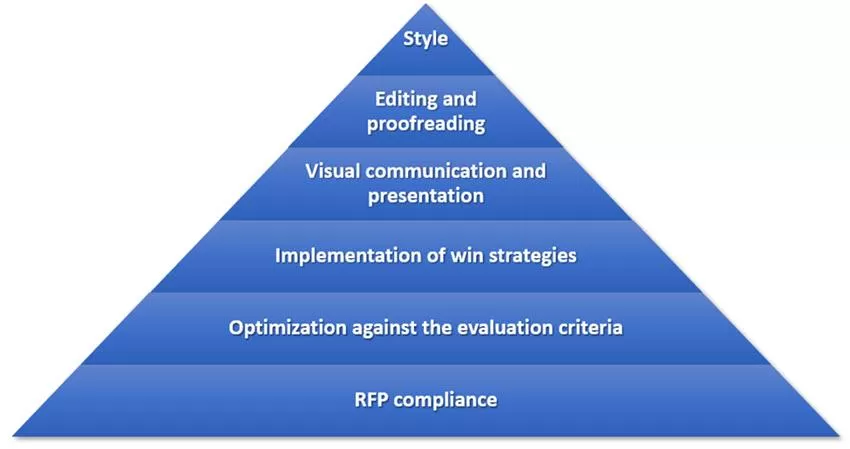Understanding how to set your priorities is key to winning proposals. There are far too many things you want to do before the deadline than are possible to achieve. If you do not have the right priorities, you will waste time and effort on things that have a lesser impact on your probability of winning.
Ideally, your priorities will perfectly match the impact of each item on your win probability. But calculating win probability is not always possible. That’s where Maslow’s Hierarchy of Needs comes in. While it was intended as an assessment tool in psychology, it can be repurposed for proposals. When applied to proposals, it provides a framework of considerations that you can use to better guide your priorities.
It also helps you be decisive by informing you what you must do, and what you should sacrifice. Because sometimes sacrifices are necessary in order to submit by the deadline. Sometimes proposal management is as much about what you’re not going to do as it is about what you are going to do.
For all the bravado we have about not being willing to make any sacrifices and being willing to do anything to win, reality forces us to make and understand our priorities. Give me a proposal professional with clear priorities over a proposal hero any day.
When Maslow's Hierarchy of Needs is applied to proposals, the base level of consideration is RFP compliance. If you are preparing a US Government proposal, RFP compliance is absolutely necessary to even get considered. Non-compliant proposals are often thrown out before being fully evaluated. RFP compliance is the foundation that everything else can be built on. However, it is not enough to win. But without RFP compliance, you are not even in the game. If you are not preparing a US Government proposal, then RFP compliance is still the foundation of your proposal strategies and offering design because it defines what the customer wants.
If your RFP contains evaluation criteria, then the very next consideration is how to achieve the maximum score. When the customer provides written evaluation criteria, it's a signal that the proposals may be scored and not read. In a formal evaluation, getting the top score is the only path to winning. In an informal evaluation, the evaluation criteria still inform your win strategies, making them a priority ahead of most others.
The next level of consideration is your implementation of your win strategies. Once you have thought through the RFP compliance and evaluation criteria considerations, how well you choose and implement your win strategies will have the biggest impact on your win probability. Before you put effort into any of the higher levels of consideration, you need a base that addresses these three areas. Another way to say this is that you can’t rely on the higher levels to win the proposal for you if you don’t have this base underneath them.
Once you have this base, you should consider visual communication and presentation. If you aren’t compliant with the RFP, don’t score the highest against the evaluation criteria, and have inadequate or poorly implemented win strategies, great visuals and presentation aren’t going to win it for you. On the other hand, if you do have those things, you are well positioned to create great visuals and know not only what to present, but what your presentation needs to achieve. People process information through visual communication better than they do through written communication. Make it a priority to turn this into an advantage for your proposal.
Beyond these considerations, if you can get there, comes editing and proofreading. While a proposal full of typos can lose, a typographically perfect proposal is not enough to win. Most customers will tolerate some typos. It’s a risk. But is it better to take the risk of typos or the risk that your bid strategies are inadequate? The priority for this is challenged. If your proposal management is successful, you'll be able to carve out the time for it. If it is not, it may lose out to other priorities that have a greater impact on win probability.
The highest level is style. Proposals against tight deadlines rarely make it to this level. You might want a proposal with multiple writers to read like there was one author. But is that the first thing to discuss or build your plans around? Is it your top priority? Or should it come up after you’ve successfully achieved the other levels in Maslow's Hierarchy?
We want to achieve all the levels. But we do not want to achieve a low impact item at the expense of a high impact item. We do not want to lose because we focused on the wrong priorities. We want to eliminate all risks. But we don’t want to play it so safe we end up losing. You don’t have to give up on creating the perfect proposal. Maybe you’ll have the time and resources to address all the levels in Maslow’s Hierarchy of (proposal) Needs. Some day. Maybe. It's an excellent goal to have.
The priorities you choose to focus on directly impact your win rate. If you have the time and resources to address the things that impact your win probability the most, then go for perfection. Proposals are a competitive sport. If you are competing against companies that will submit compliant, high scoring, proposals based on sound win strategies, then the higher levels might become the difference between winning and losing. But first you need to achieve a compliant, high scoring, and competitive proposal.



Join the conversation
You can post now and register later. If you have an account, sign in now to post with your account.
Note: Your post will require moderator approval before it will be visible.